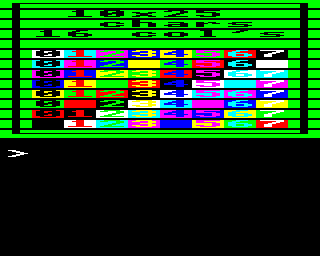MODE 9
MODE 9 is the unofficial title of an ultra-low resolution screen MODE, developed by Ian Robertson and published in The Micro User magazine (November 1985, p.123). It works on the BBC Micro but not the Electron or Master, or the Archimedes (where MODE 9 is officially a 16-colour version of MODE 1).
The MODE 9 code adapts the MODE 6 screen to provide a 10 × 25 text display in 16 colours. The MOS does not allow complete support of this MODE and some bugs can be seen: for instance, text windows do not work correctly.
| Type | Bitmapped, text only ('ASCII') | |
| Resolution | Text | 10 × 25 characters |
| Graphics | n/a | |
| Character size | 8 × 10 pixels, top 8 lines user definable | |
| Pixel aspect | 4:1 (wide) | |
| Bits per pixel | 4 | |
| Default palette | Logical colour | Actual colour |
|---|---|---|
| 0 | 0 (black) | |
| 1 | 1 (red) | |
| 2 | 2 (green) | |
| 3 | 3 (yellow) | |
| 4 | 4 (blue) | |
| 5 | 5 (magenta) | |
| 6 | 6 (cyan) | |
| 7 | 7 (white) | |
| 8 | 8 (flashing black/white) | |
| 9 | 9 (flashing red/cyan) | |
| 10 | 10 (flashing green/magenta) | |
| 11 | 11 (flashing yellow/blue) | |
| 12 | 12 (flashing blue/yellow) | |
| 13 | 13 (flashing magenta/green) | |
| 14 | 14 (flashing cyan/red) | |
| 15 | 15 (flashing white/black) | |
| Memory | allocated | 8192 bytes |
| on screen | 8000 bytes | |
| Address range | Model B etc. | &6000..&7FFF |
| Configuration | Video ULA control register | &80 |
| Video ULA palette register file | &07 &16 &25 &34 &43 &52 &61 &70 &8F &9E &AD &BC &CB &DA &E9 &F8 | |
| CRTC register file | &3F &28 &31 &24 &1E &02 &19 &1B &01 &09 &67 &09 (from table in MOS 1.20 at &C492..&C49D) | |
MODE 9 is also the unofficial title of a medium-resolution screen MODE, selectable with the *MODE command or the NewModes sideways ROM module.[1]
The MODE 9 code adapts the MODE 2 screen to provide a 4-colour version of MODE 1, 40 × 32 characters in 4 colours. It does this by redefining the character set to provide thin characters.
| Type | Bitmapped | |
| Resolution | Text | 40 × 32 characters |
| Graphics | 160 × 256 | |
| Character size | 4 × 8 pixels | |
| Pixel aspect | 2:1 (wide) | |
| Bits per pixel | 2 | |
| Default palette | Logical colour | Actual colour |
|---|---|---|
| 0 | 0 (black) | |
| 1 | 1 (red) | |
| 2 | 3 (yellow) | |
| 3 | 7 (white) | |
| Memory | allocated | 20480 bytes |
| on screen | 20480 bytes | |
| Address range | Model B etc. | &3000..&7FFF |
| Configuration | Video ULA control register | &D4 |
| Video ULA palette register file | &07 &17 &26 &36 &47 &57 &66 &76 &84 &94 &A0 &B0 &C4 &D4 &E0 &F0 | |
| CRTC register file | &3F &28 &31 &24 &26 &00 &20 &22 &01 &07 &67 &08 | |
MODE 9 can be created manually with the following code running in the I/O processor.
BASIC: MODE 2 :REM Base MODE ?&30A=39 :REM Characters per line ?&34F=8 :REM Bytes per character *FX154,212 6502: LDA #22:JSR OSWRCH LDA #02:JSR OSWRCH \ Base MODE LDA #&27:STA &30A \ Characters per line LDA #&08:STA &34F \ Byte per character LDA #154:LDX #212:JSR OSBYTE \ Cursor width
The character set needs to be redefined to be four pixels wide, such as with the one used with NewModes.
See Also
References
-- Jgharston (talk) 17:22, 12 October 2016 (UTC) beardo 12:52, 20 September 2006 (BST)

